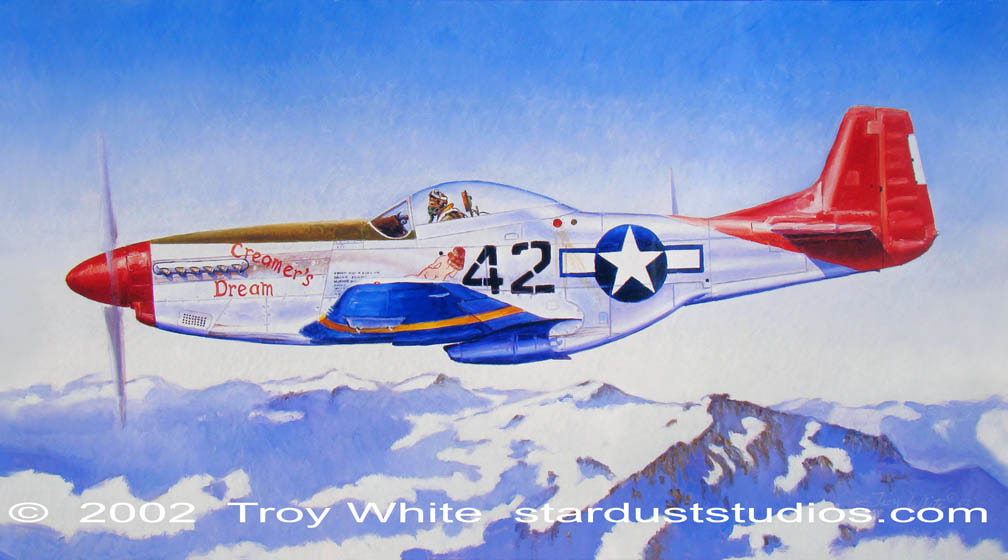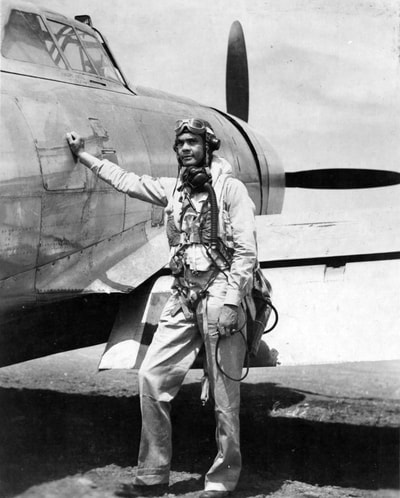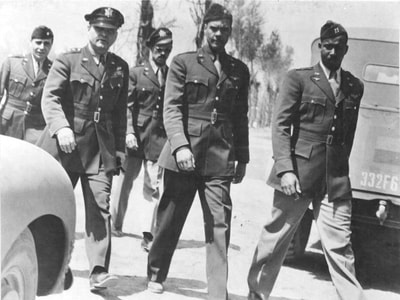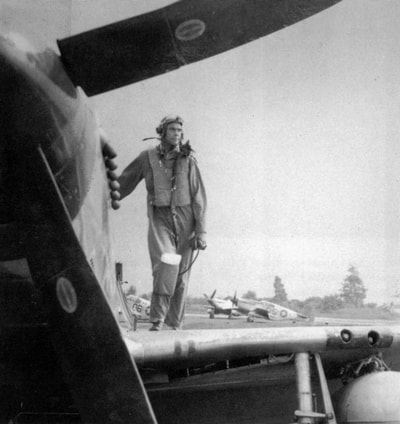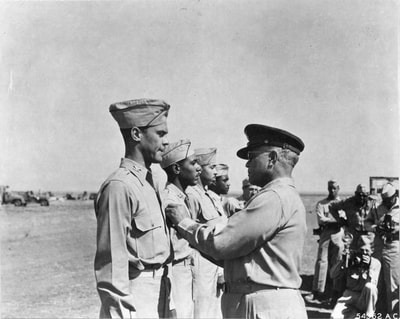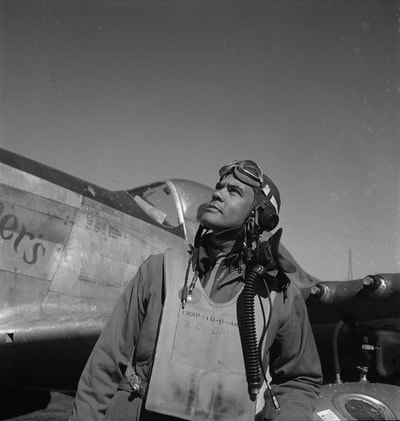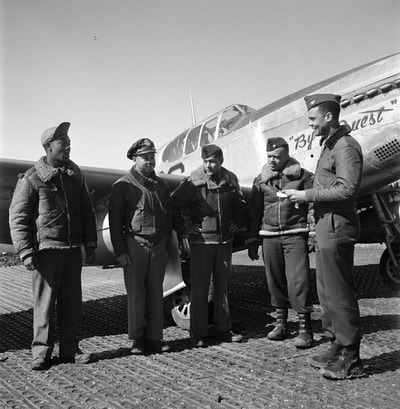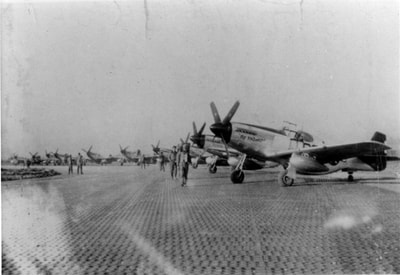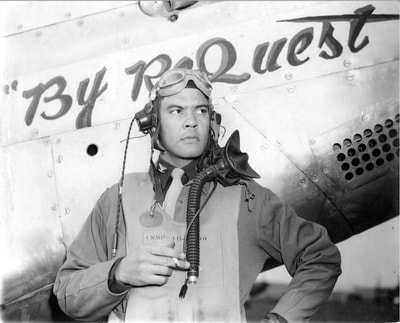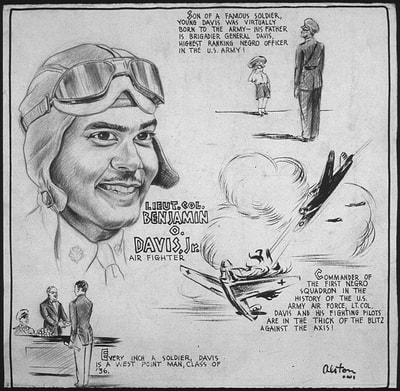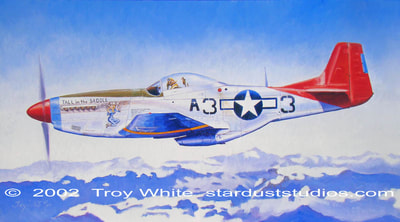Tuskegee Airman Benjamin O. Davis Jr.
"Creamer's Dream" Oil on Canvas 19" x 33" Troy White © 2002
Benjamin O. Davis Jr. was born in Washington, D.C., in 1912. He graduated from U.S. Military Academy at West Point in June 1936 with a commission as a second lieutenant of infantry. In May 1941 he entered Advanced Flying School at Tuskegee Army Air Base and received his pilot wings in March 1942.
Davis was made CO of the 99th Fighter Squadron at Tuskegee Army Air Field and deployed with his unit to North Africa in April 1943. The 99th flew its first combat mission in P-40L type aircraft on a patrol over the Mediterranean Sea. At this juncture they were attached to the 33rd Fighter Group. They were tasked with ground support, fighter-bomber missions as well as escorting bombers. A month later on the first of July Lt. Charles B. Hall of Brazil Indiana scored the first victory for the squadron when he shot down an FW-190 while escorting B-25 medium bombers on a raid to Castelvetrano in south-western Sicily. Lt. W. I. "Ace" Lawson also claimed the probable destruction of another FW-190 and damaged an Me-109.
In late August after less than three months in combat, Davis was sent back to the United States. He arrived home and found there was a move to prevent the further use of black pilots in combat. Senior white officers in the Army Air Forces had recommended Army chief of staff, General George Marshall, that the 99th be removed from combat operations citing a poor performance record. Davis was ordered to testify on 16 October 1943 before the Senate Advisory Committee in Washington DC where he was grilled with charges of the alleged poor performance of his men. Davis effectively fielded the questions but General Marshall ordered an inquiry while allowing the 99th to remain in combat. The inquiry eventually reported that the 99th's performance was comparable to other air units, but any questions about the squadron's fitness were answered on 27 January 1944 when its pilots shot down 10 Nazi planes over the Anzio Beachead and followed those victories with a further three the following day.
Davis was made CO of the 99th Fighter Squadron at Tuskegee Army Air Field and deployed with his unit to North Africa in April 1943. The 99th flew its first combat mission in P-40L type aircraft on a patrol over the Mediterranean Sea. At this juncture they were attached to the 33rd Fighter Group. They were tasked with ground support, fighter-bomber missions as well as escorting bombers. A month later on the first of July Lt. Charles B. Hall of Brazil Indiana scored the first victory for the squadron when he shot down an FW-190 while escorting B-25 medium bombers on a raid to Castelvetrano in south-western Sicily. Lt. W. I. "Ace" Lawson also claimed the probable destruction of another FW-190 and damaged an Me-109.
In late August after less than three months in combat, Davis was sent back to the United States. He arrived home and found there was a move to prevent the further use of black pilots in combat. Senior white officers in the Army Air Forces had recommended Army chief of staff, General George Marshall, that the 99th be removed from combat operations citing a poor performance record. Davis was ordered to testify on 16 October 1943 before the Senate Advisory Committee in Washington DC where he was grilled with charges of the alleged poor performance of his men. Davis effectively fielded the questions but General Marshall ordered an inquiry while allowing the 99th to remain in combat. The inquiry eventually reported that the 99th's performance was comparable to other air units, but any questions about the squadron's fitness were answered on 27 January 1944 when its pilots shot down 10 Nazi planes over the Anzio Beachead and followed those victories with a further three the following day.
Meanwhile it was decided to allow Lt. Col. Davis to take the all black 332d Fighter Group which was based at Selfridge Field, Michigan into combat. On 3 January 1944 the 332d Fighter Group and its three fighter squadrons, the 100th , 301st , and 302nd, departed Hampton Roads, Virginia on four ships in a convoy headed for the Mediterranean. The 332nd were based at first based at Montecorvino Italy and began flying operations on 5 February 1944 in the Bell P-39 Aircobra, In they moved to Capodichino and converted to the P-47 Thunderbolt. Finally, in May 1944 they were assigned to the 15th Air Force and moved to Ramitelli, Italy where they were joined by the 99th FS making the 332nd the only four squadron group in the USAAF. In June they converted to the P-51 Mustang. Known as the "Red Tails" because of the colour they painted the tails of their aeroplanes the 332nd established a bomber protection record that was second to none.
By the end of the war the Tuskegee Airmen had compiled an outstanding combat record. They flew more than 15,000 sorties, shot down 112 enemy planes, and destroyed or damaged 273 on the ground at a cost of 66 of their own planes while losing very few bombers to enemy fighters. Colonel Davis led by example and continued flying combat missions right up to the end of hostilities. He remained in the Air Force after the war and again flew combat missions in the F-86 Sabre in Korea. In 1953 he assumed command of the51st Fighter Interceptor Wing. He retired from active military service on February 1, 1970. On December 9, 1998, Davis Jr. was promoted to general, U.S. Air Force (retired), with President Bill Clinton pinning on his four-star insignia. He passed away on 4 July 2002.
General Davis' military decorations include the Air Force Distinguished Service Medal, Army Distinguished Service Medal, Silver Star, Legion of Merit with two oak leaf clusters, Distinguished Flying Cross, Air Medal with four oak leaf clusters, Air Force Commendation Medal with two oak leaf clusters and the Philippine Legion of Honour. He was a command pilot.
By the end of the war the Tuskegee Airmen had compiled an outstanding combat record. They flew more than 15,000 sorties, shot down 112 enemy planes, and destroyed or damaged 273 on the ground at a cost of 66 of their own planes while losing very few bombers to enemy fighters. Colonel Davis led by example and continued flying combat missions right up to the end of hostilities. He remained in the Air Force after the war and again flew combat missions in the F-86 Sabre in Korea. In 1953 he assumed command of the51st Fighter Interceptor Wing. He retired from active military service on February 1, 1970. On December 9, 1998, Davis Jr. was promoted to general, U.S. Air Force (retired), with President Bill Clinton pinning on his four-star insignia. He passed away on 4 July 2002.
General Davis' military decorations include the Air Force Distinguished Service Medal, Army Distinguished Service Medal, Silver Star, Legion of Merit with two oak leaf clusters, Distinguished Flying Cross, Air Medal with four oak leaf clusters, Air Force Commendation Medal with two oak leaf clusters and the Philippine Legion of Honour. He was a command pilot.

Creamer's Dream
Open Edition Canvas Giclée Print. Image size: 18"x10"
This painting is one part of a quadriptych featuring one plane of each of the four squadrons which made up the all black 332nd Fighter Group- the famed Tuskegee Airmen. "Creamer's Dream" was a P-51D assigned to Lt. Charles White of the 301st FS, 332nd FG in 1945. White is credited with two victories scored during the big April Fool's dogfight on 1 April 1945.
$
90.00
*NEW*
The Tuskegee Airmen Quadriptych by Troy White
Canvas Giclée prints available now!
Collect all Four!
The Tuskegee Airmen Quadriptych by Troy White
Canvas Giclée prints available now!
Collect all Four!
